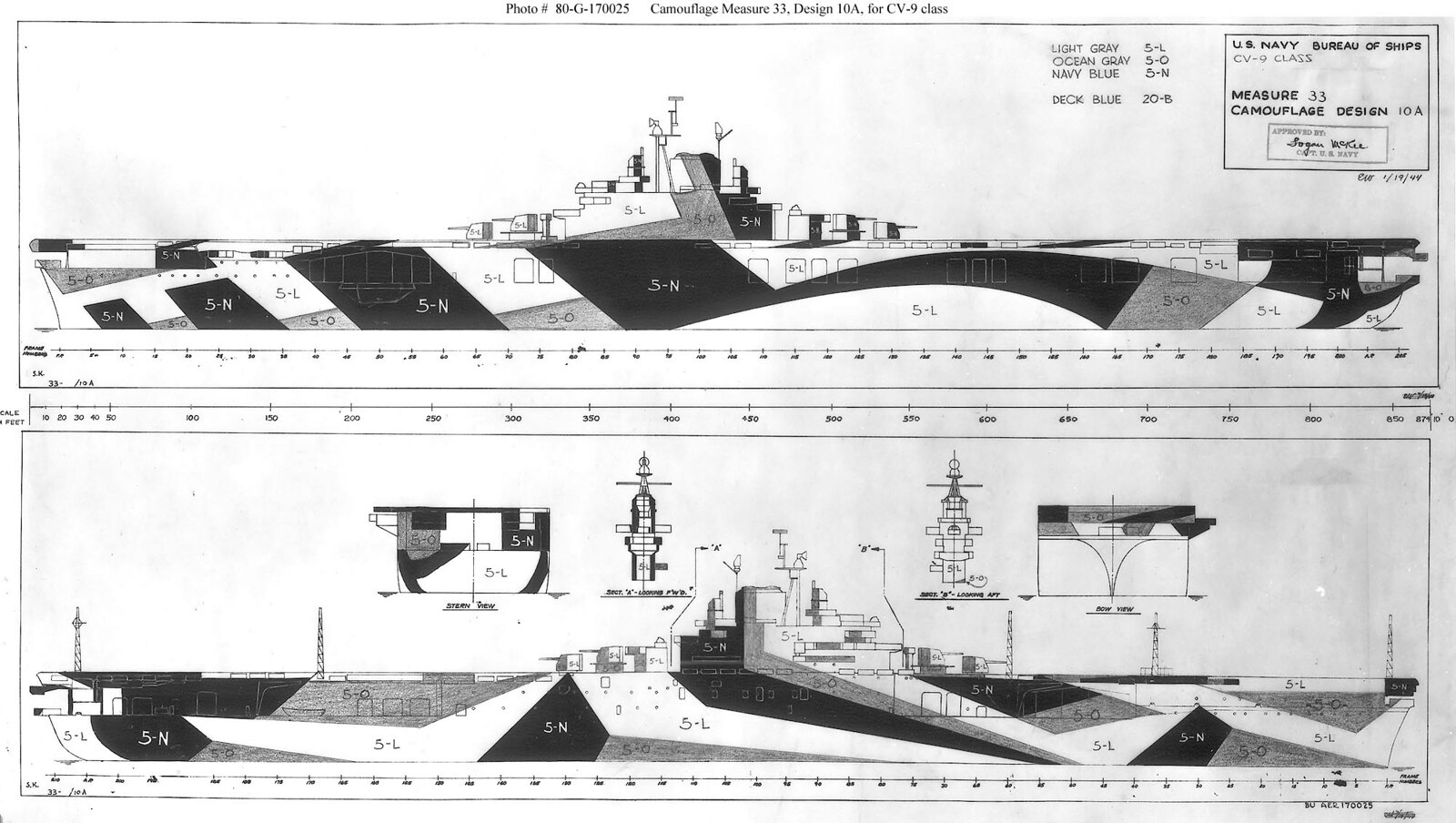Hello Guys,
Just confirming something.
The USS ESSEX, CV-9, … When did she wear Measure 33-10A? 80-G-170025 says 1-19-1944.
 Pattern_sheet%2C_MS-33_10A_for_Essex_class by Tim Connelly, on Flickr
Pattern_sheet%2C_MS-33_10A_for_Essex_class by Tim Connelly, on Flickr
And, the Mariana’s Turkey Shoot took place on June 19th and 20th, 1944. So – would Measure 33-10A be accurate for the ESSEX during that operation?
Tim
As far as I can tell…never.
Snyder and Short says M21 in 1943, M32, 6-10d in 1944, and back to M21 in 1945.
Navsource shows a number of photos of CV-9 after refit in San Francisco, where it is stated that in April 1944 she was repainted M32, 6-10d.
Her immediate successor CV-10 was painted in the measure- pattern you show.
Hi, A modeler named Scott Dunn just told me that ESSEX was in Measure 32-6D at the time of the Mariana’s Turkey Shoot …  20375724_10211989003614237_3832709988110055193_n by Tim Connelly, on Flickr Tim
20375724_10211989003614237_3832709988110055193_n by Tim Connelly, on Flickr Tim
USS ESSEX CV-9
Commissioning to refit April 1944 carried Measure 21. From refit to at least 25 November 1944 (the Kamikaze hit) carried measure 32/6-10D. She was the only carrier that ever had this camo. The change back to measure 21 may have been done at Ulithi while undergoing flight deck repairs.
EJ
Assistant Treasurer
USS ESSEX CV/CVA/CVS-9/LHD-2 Association
Hi.
May I ask all of you a question? For a 1:700 CV, like the ESSEX, would you use invisible fishing line for the rigging?
Tim
I think so. I used to swear by the elastic stuff called EZ Line, but I’m having my second thoughts now. It’s breaking on it’s own on some of the models I have used it on. And my spool of it sort of melted and is useless.
Now I’m back to using thin monofilament. There’s a thin one made for fly tying called Uni Caenis. One nice thing is that it holds knots.
I also have switched to the monofilament fly tying thread. I have some 5 mil stuff- two rolls, one black, and one white/translucent. I use it on smaller ships and smaller scale, like 1:700. It looks fantanstic- you can barely see it.
However, that brings up a problem. When I am doing the rigging, I can barely see it- at times it completely disappears, even though I wear 2.25 diopter cheaters when doing rigging. I have found something that helps. I have made to backdrops of foamcore, one white, the other black. I use whichever is the complement to the color thread I am using. When the thread is seen against that backdrop, it is visible. However, when I try to see either thread against the ship- looking downward towards the deck, it disappears if the ship has a medium gray finish! Then rigging gets really hard!
My philosphy has been that oversize rigging is worse looking than undersize, and I always try to err on the side of thinner rigging. But now that I can get stuff that is that thin, I have the dilemma- thread that is too thin to be visible is a real struggle.
In thicker stuff I try to pick color that will reduce contrast, which makes it look thinner (I won’t get into the visibility theory on which that statement is based). In thicker threads that give me a choice of color, that is a good way to do it- pick a medium gray or cream or tan color- but that ultra thin stuff does not give you much choice of color.
As a final thought- really good, positionable lighting is really important in rigging small scale models.
 Pattern_sheet%2C_MS-33_10A_for_Essex_class by Tim Connelly, on Flickr
Pattern_sheet%2C_MS-33_10A_for_Essex_class by Tim Connelly, on Flickr